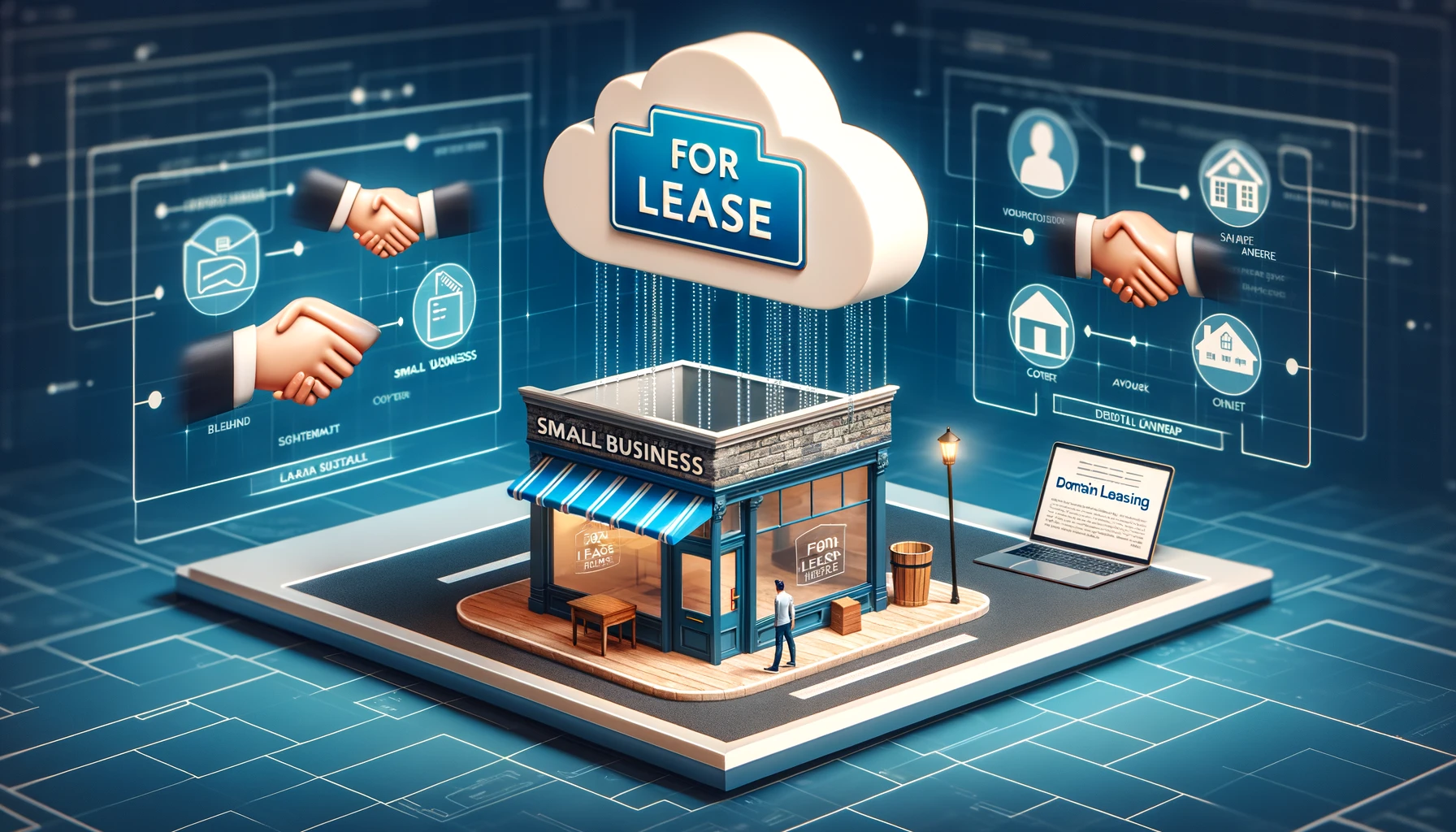Imagine stepping into the world of real estate, but instead of buildings and land, you’re dealing with digital property. That’s domain leasing for you. Shifting our perspective on digital footprints and entrepreneurial tactics is revolutionizing the playing field.
Today, we will peel back the layers on what defines a stellar domain name and its critical role in today’s digital arena. You’ll get to explore the ins and outs of different lease types—understanding these could save you from potential pitfalls.
We also touch on negotiating tactics that ensure your marketing budget stretches further while keeping your online turf prime for visitor traffic. Plus, if investing is your jam or selling domains sounds like a plan, there are golden nuggets here for you, too.
Let’s start peeling back the layers on domain leasing basics; trust me, it’s as intriguing as it sounds.
Table Of Contents:
- Understanding the Basics of Domain Leasing
- Exploring Different Types of Domain Leases
- Benefits and Drawbacks of Domain Type-in Traffic
- Negotiating Marketing Budget for Domain Lease Agreements
- The Art of Investing in Domains
- How to Evaluate and Increase Your Domain’s Value
- Selling Your Domain: A Step-by-Step Guide
- Understanding Lease-to-Own Domains
- Conclusion
Understanding the Basics of Domain Leasing
Domain leasing is a practice that offers flexibility and support to businesses looking to establish their online presence without the upfront commitment of purchasing a domain outright.
This arrangement typically involves a domain name owner providing the use of their domain to a lessee in exchange for service fees, which are often calculated as a percentage of the agreed terms.
Essential to this process is domain support, ensuring that the technical aspects of managing the domain run smoothly and efficiently.
It’s also crucial for both parties to be clear about the business terms, including the duration of the lease and any specific conditions tied to the use of the domain.
Moreover, respecting trademark rights is paramount to avoid legal complications and ensure that the domain’s use does not infringe on any existing intellectual property.
Finally, maintaining accurate ownership records is vital for transparency and for upholding the integrity of the agreement. They provide a clear trail of the domain’s history and its current status under the lease agreement.
What is a Domain?
A domain is essentially your website’s address on the Internet. It’s how customers find you online and remember where to come back. Think of it as your digital street sign in the vast neighborhood that is the web.
Picking the right domain name isn’t just about finding something catchy; it reflects your brand and can impact SEO. A memorable, relevant domain name makes it easier for people to find and return to your site.
Dive into Verisign’s guide to craft a domain name that captures attention and embodies your brand essence.
Role of a Domain Registrar
The role of a domain registrar might seem complex, but think of them as real estate agents for web addresses. They manage the reservation of internet domains, ensuring you can claim yours without overlap or conflict with others.
Selecting a reputable registrar is crucial because they’re responsible for securing your online real estate. Companies such as GoDaddy not only secure your digital turf but also offer hosting services, making the upkeep of your internet persona a breeze.
Criteria for a Good Domain Name
- A good domain should be easy to spell and remember. You want potential visitors to be able to type in or recall your URL without getting lost.
- Your chosen name must resonate with what you do: If someone hears it out loud without seeing how it’s spelled, will they still know what kind of business or content they’ll find?
- The best domains avoid numbers and hyphens since these elements complicate typing and remembering URLs.
Finding that perfect blend between catchy and straightforward can feel daunting, but following these guidelines will get you closer than ever. Remember: Your choice lays down foundational aspects concerning branding strategies moving forward.
Choosing the right domain is key: your web address impacts how easily customers find you. Go for memorable, brand-reflective names without numbers or hyphens to make it easy for visitors. Pick a trustworthy registrar to keep your online spot secure.
Exploring Different Types of Domain Leases
Gross Lease vs. Net Lease
Imagine you’re renting an apartment. A gross lease is like paying one bill that covers rent and all utilities—it’s simple. In the domain world, a gross lease means your monthly payment includes the domain name plus any associated services like hosting or management fees. Opting for a gross lease is akin to embracing ease, amalgamating the rent with supplementary amenities into one uncomplicated payment.
In contrast, a net lease in real estate usually involves tenants paying some or all of the property expenses on top of rent—more responsibility but potentially lower base cost. For domains, this translates to separate charges for the domain itself and additional fees for services used alongside it.
Single, Double, and Triple Net Leases
Digging deeper into net leases gives us single (N), double (NN), and triple (NNN) varieties—each adding more responsibilities onto the lessee’s plate:
- A single-net lease, N, requires lessees to pay one extra expense, such as property taxes and rent.
- The double-net lease, NN, adds another layer by including insurance premiums on top of property taxes.
- Last up is the triple-net lease, which adds maintenance costs to taxes and insurance bills, putting the tenant under much more financial responsibility than its counterparts.
Single-Tenant and Multi-Tenant Leases
Whether you’re going solo or bringing friends, it defines whether you’ll lean towards single-tenant or multi-tenant leases, respectively. With a single-tenant setup, e.g., a startup leasing a unique domain exclusively for branding—you get total control but at higher prices due to exclusivity perks.
Benefits and Drawbacks of Domain Type-in Traffic
Type-in traffic, where users directly enter a website’s domain name into their browser, is like finding money in your pocket you forgot about. Stumbling upon type-in traffic is akin to the unexpected joy of discovering forgotten cash, yet its reliability as a steady revenue stream remains questionable. Not really.
One major perk of type-in traffic is its high conversion rate. People who take the time to punch in your URL are likely already interested in what you offer. This audience is gold because they’re closer to purchasing or taking another desired action on your site.
However, banking solely on type-in traffic puts all your eggs in one basket. This traffic volume tends to be low since not everyone remembers URLs by heart anymore, thanks to search engines doing the heavy lifting. Plus, if your domain isn’t straightforward to remember (think “best-pizza-new-york-city.com”), expecting significant type-in traffic might lead to disappointment.
Growing Your Type-In Traffic
To boost type-in traffic, start with an easy-to-remember and relevant domain name that aligns with what people are searching for online related to your niche. Consider how domains like “Cars.com” benefit from simple yet powerful branding that sticks easily in someone’s mind.
Beyond choosing a memorable name, promoting your URL through offline channels such as business cards or print ads can encourage more direct visits.
Moz’s Beginner’s Guide To SEO, offers further insight into leveraging various strategies beyond just hoping for serendipitous visitors typing out long URLs.
Lastly, always prioritize user experience so those who arrive via type-ins stay longer and engage deeper with your content.
Negotiating Marketing Budget for Domain Lease Agreements
Imagine you’re eyeing a prime piece of digital real estate, but the upfront buying cost is steep. Here’s where domain leasing shines, offering a path to secure that perfect domain without breaking the bank initially. However, one key aspect often overlooked in this excitement is negotiating a marketing budget within these agreements.
Understanding the Impact of Marketing on Leased Domains
A robust marketing plan can transform a decent domain into an internet juggernaut. But remember, just because you’ve leased it doesn’t mean traffic will magically appear. It would help if you fueled its potential with targeted marketing efforts. Allocating funds towards SEO and content creation specifically tailored for your audience boosts visibility and engagement significantly.
When drafting lease terms, clearly outline who handles which aspects of marketing—whether it’s solely your responsibility or if there’s shared input from the lessor. Making sure everything’s clear from the get-go can sidestep future disputes and align everyone towards a shared goal of thriving together.
The Art of Negotiation: Striking Balance
According to Forbes, negotiating isn’t about demanding what you want but finding common ground where both sides benefit. Start by understanding your lessor’s goals with their domain. Are they looking for a steady income? Increased exposure? Tailoring your pitch around their objectives makes them more receptive to including a reasonable marketing budget in your agreement.
In discussions, be prepared with data backing why investing in marketing benefits you and enhances the value of your asset over time—a win-win scenario enticing enough for any savvy investor or lessor.
The Art of Investing in Domains
What is Domain Investing?
Think of domain investing like real estate for the internet. Just as prime land can skyrocket in value, so can web addresses if you play your cards right. But why? Because every website needs a catchy, memorable name that users can quickly type into their browser. When you buy domains with potential, you’re essentially betting on digital property.
It’s not mere speculation; the digital landscape is dotted with numerous tales of triumph. For example, CarInsurance.com sold for $49.7 million. If those numbers make your eyes pop, you’re not alone.
Benefits of Domain Investing
The allure of domain investing comes down to its unique advantages. First, it’s flexible—buy or sell on your schedule without worrying about market hours or locations since everything happens online.
Besides flexibility, let’s talk profitability. With the right strategy and a dash of luck, domains purchased at low prices today could be worth thousands—or even millions—tomorrow.
Last is accessibility; anyone with an internet connection and some capital can start dabbling in domain sales thanks to platforms like GoDaddy Auctions or Sedo, where buying and selling happen round-the-clock.
How to Make Money with Domain Investing?
Making money from domain investing involves two main strategies: long-term holds and quick flips. Holding onto domains means waiting for their value to increase before selling them at a profit—like aging fine wine until it’s just suitable for sale.
But sometimes opportunity knocks early; flipping involves purchasing domains only to sell them shortly afterward when demand spikes, perhaps due to recent trends or emerging technologies.
NameCheap and its peers offer valuable perspectives on prevailing market needs, guiding investors in making educated choices between holding or flipping domains based on the freshest information, a critical component for thriving in investment endeavors.
Think of domain investing as internet real estate, where buying low-potential web addresses can lead to big profits. You could sell for millions with the right strategy and a bit of luck. Domain investing is flexible, profitable, and accessible to anyone with an internet connection.
How to Evaluate and Increase Your Domain’s Value
Factors Influencing Domain Value
Evaluating your domain’s value isn’t just about how catchy it is. It digs deeper into its length, keyword relevance, and brand-ability. Shorter domains are often more valuable because they’re easier to remember. A domain with trending keywords can catch a higher price tag due to its SEO potential.
Another critical factor is the Top-Level Domain (TLD). While .com reigns supreme regarding value perception, niche TLDs like .tech or .ai have started carving out their own spaces in specific industries. A domain’s historical performance also plays a role; you’re sitting on digital gold if it has high traffic volumes or an established backlink profile.
Strategies to Increase Your Domain’s Worth
Initiating an uptick in your domain’s valuation begins by refining its SEO groundwork. By optimizing your site to appear for key search terms, you draw in more visitors and heighten its allure to those looking to invest in a domain already visible on search engines.
Leveraging social media can significantly enhance your domain’s appeal by demonstrating active engagement and audience interest. Creating quality content that drives interaction will ensure that eyes stay glued where you want them—on your site.
Last but not least, consider developing the website hosted on the domain into a fully-fledged business or popular blog before selling. A turnkey solution with steady revenue streams commands top dollar in today’s market. GoDaddy offers additional insights for those eager to enhance the value of their domain further.
Selling Your Domain: A Step-by-Step Guide
Listing Your Domains for Sale
First, you must let the world know your domain is up for grabs. The best way to do this is by listing it on popular online marketplaces such as Sedo or Flippa. On these sites, your domain gets spotlighted by eager buyers searching for their new digital treasure.
An essential tip is to set a clear and realistic price. Research similar domains that have recently sold to understand your worth. Additionally, weaving an engaging narrative about your domain’s unique advantages and possible applications can significantly heighten buyer intrigue.
Finding a Buyer
Finding the right buyer can sometimes feel like searching for a needle in a haystack, but patience pays off. Apart from listing sites, leveraging social media platforms and relevant forums can help spread the word about your sale further.
Networking with web developers and companies within industries related to your domain’s keywords can also lead directly to interested parties. Forging genuine relationships frequently accelerates the sale cycle and minimizes price negotiations.
Transferring the Domain
Once you’ve sealed the deal with a buyer, transferring ownership of the domain is next on your list. Each registrar has its transfer process; however, most follow similar steps involving unlocking the domain and providing an authorization code (EPP code) to initiate transfers securely.
You’ll want to ensure all fees are settled before beginning this process because unpaid fees can cause delays or cancellations mid-transfer. ICANN’s Transfer Policy offers more detailed guidance on how these transfers should be handled globally, ensuring that sellers’ and buyers’ interests are protected.
Understanding Lease-to-Own Domains
What is Lease to Own?
A lease-to-own domain strategy is like a rent-to-own home deal but for internet real estate. You agree to lease the domain with an option to buy it outright. Opting for this strategy allows you to snag a top-tier web address without laying down the full payment immediately.
Entrepreneurs and companies increasingly favor acquiring sought-after or brand-worthy domains without the immediate need to invest a large amount of capital. It’s a strategic move that can provide leverage in competitive markets.
How does Lease to Own work?
The process starts when both parties agree on terms: monthly payments, total price, and lease duration before ownership transfer. Typically, part of your monthly payment goes towards the purchase price. If you decide not to buy, those funds aren’t refunded—think of it as paying for the right first dibs.
Finding reputable platforms that facilitate these agreements is crucial because they ensure everything runs smoothly and legally binding contracts protect both sides. Namecheap and Dan.com are two popular options known for their reliability in handling such transactions.
Managing Your Lease-to-Own Domain
Maintaining control over your leased domain requires attention similar to fully owned ones. Ensuring security measures are up and SEO strategies are implemented effectively throughout your leasing period will benefit you long-term, whether or not you decide to purchase eventually.
Paying on time also matters greatly; missing payments could mean losing rights over the domain even if you invested significantly into its development or branding efforts during this phase, so setting reminders or automating payments might be wise moves here.
In conclusion, this innovative arrangement provides flexibility while securing online assets critical for business growth in today’s digital landscape. Dilligence in management is a critical part of the equation for success down the line.
Lease-to-own domains let you lock in premium internet real estate without all the cash up front, a savvy move for a competitive edge. Like rent-to-own homes, this strategy requires careful management and timely payments to secure your digital footprint effectively.
Conclusion
You delve into the domain leasing basics. Let’s take that understanding off the shelf and apply it in real scenarios.
Remember: Choosing the right domain can set your business up for success. Think of it as valuable and vital digital real estate.
Understand this: Not all leases are created equal. Knowing the difference between gross and net leases could save you considerable time.
Acknowledge this: Investing in domains isn’t just about buying; it’s knowing when to hold, sell, or lease for profit.
Finally, ensure your online presence is strong by negotiating smartly and increasing your domain’s value whenever possible.
If there’s one thing to take away from diving deep into Domain Leasing Basics, let it be how essential a good strategy is—from selection through negotiation to investment. Embark on this journey equipped with these insights; they are fundamental in constructing a robust digital presence.





